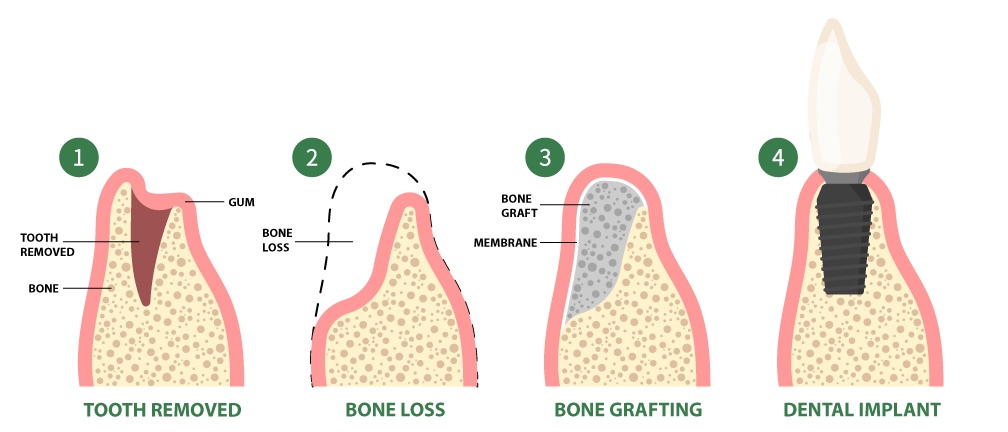Bone Grafting Procedure
Tooth extraction often leads to the loss of bone mass and the collapse of soft tissues in the affected area, causing a disruption in the normal contours of the jaw. To restore the area for dental implant placement, it is sometimes necessary to perform grafting procedures. This is especially relevant when dealing with atrophied areas, where minor bone grafting during the extraction can help maintain the natural anatomical structure, facilitating subsequent dental implant restoration without the need for extensive grafting.
Patients typically opt for commercially prepared bone graft products, or in some cases, bone can be harvested from other intraoral sources. This approach ensures a successful grafting procedure.
By reinforcing the foundation on which both natural teeth and dental implants rely, bone grafts effectively replace lost bone tissue and, through specific techniques, stimulate the growth of new bone. Consequently, this procedure enhances the durability, aesthetics, and functionality of teeth and dental restorations.

Our treatment approach is tailored to the needs of our patients. When it comes to procedures involving bone grafting, sedation is commonly administered to ensure you can comfortably rest throughout the entire process.
Frequently, bone grafting is performed in conjunction with dental implant restoration or as part of jaw surgery, and additional procedures may be conducted during your appointment alongside the graft itself.
In the bone graft phase of the surgery:
Typically, the doctor acquires the bone graft material from a tissue bank based on your preferences. These grafting materials eliminate the need for an extra surgical site and generally demonstrate high success rates. Alternatively, the doctor may utilize graft material from your own body’s donor site, often from the jaw, hip, or knee area.
The doctor will graft the chosen material onto your jawbone. Following the placement, your doctor will shape the graft, enhancing its natural appearance and ensuring a sturdy, stable foundation.
Post-surgery, you might experience mild soreness and swelling for a few days. For our patients undergoing minor grafting, returning to work within a day or two is common. Those with more extensive grafting requirements may need additional time before feeling comfortable resuming regular daily activities.
Typically, patients may need three to four months for the bone and graft to fully integrate before scheduling follow-up procedures. However, there are instances where patients exhibit sufficient strength at the graft site, allowing doctors to combine grafting and implant placement in a single surgery.
Taking care of the surgical site is relatively simple. The grafts placed by our doctors are usually particulate or sand-like, enabling precise shaping to match the targeted area. It’s normal to observe some loose particles during the healing process.
Following your bone grafting procedure, anticipate a reinforced foundation for your dental implants or jaw surgery. This crucial phase contributes to a more enduring result, enhanced predictability, and an overall improved aesthetic appearance.
